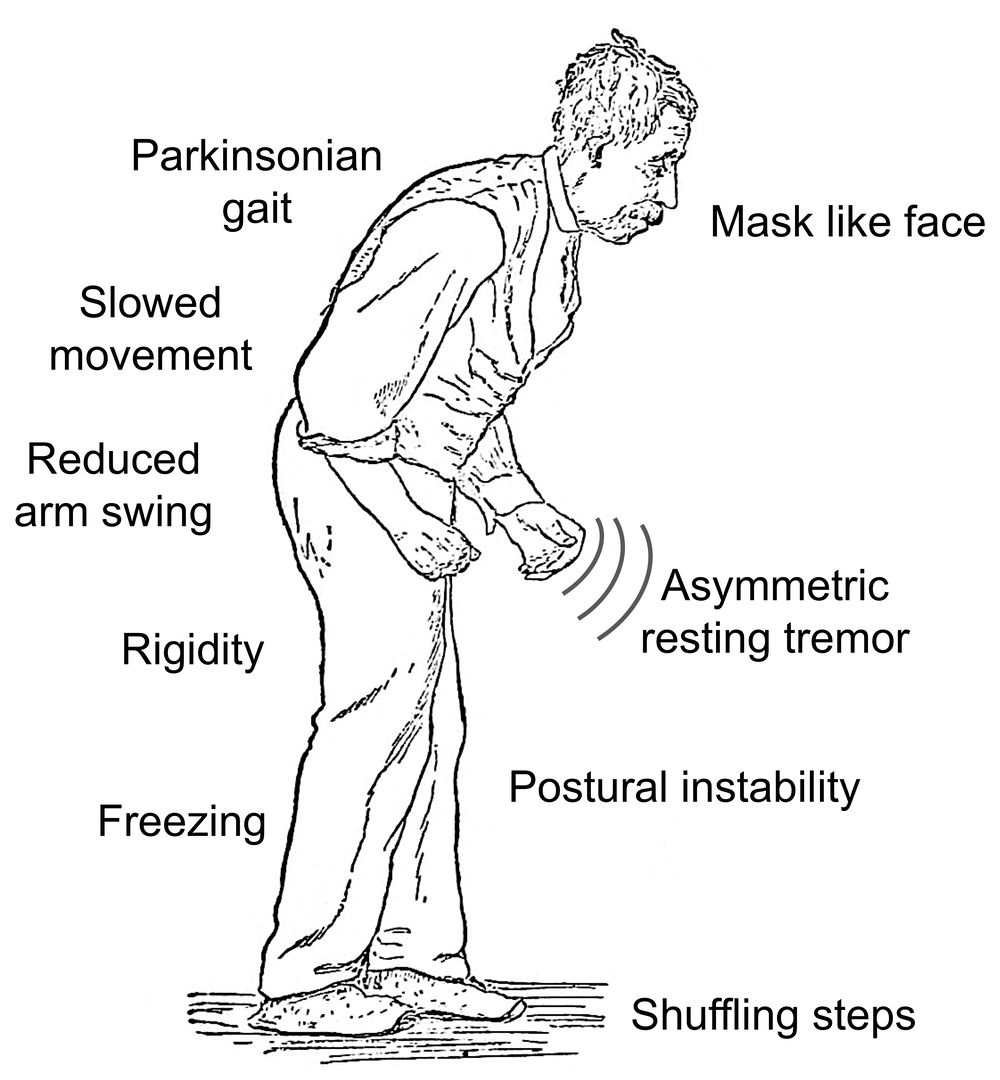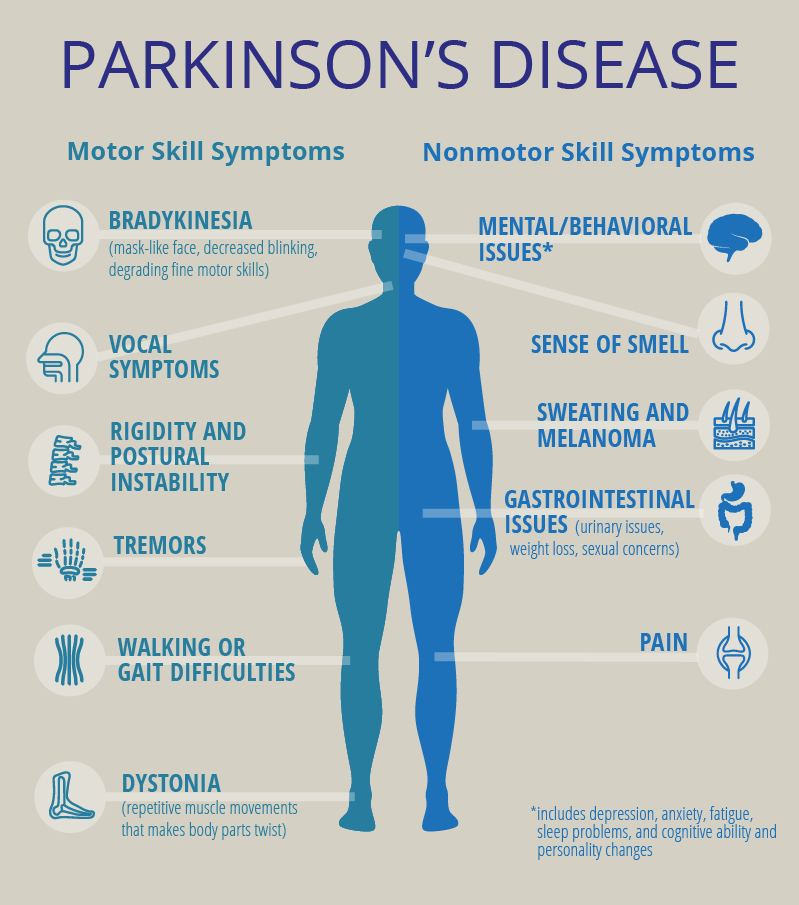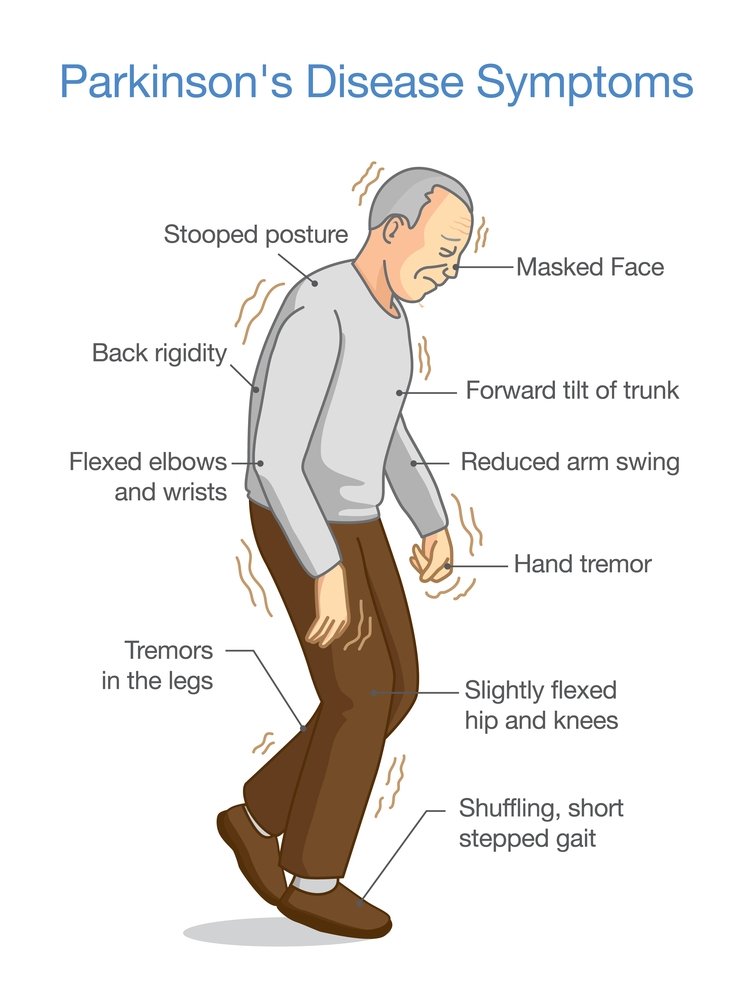Causes Of Parkinsons Disease
At present, we do not know the cause of Parkinsons disease. In most people there is no family history of Parkinsons Researchers worldwide are investigating possible causes, including:
- environmental triggers, pesticides, toxins, chemicals
- genetic factors
- combinations of environment and genetic factors
- head trauma.
How Quickly Do Symptoms Progress
The rate of progression of Parkinsons disease varies from person to person. It is difficult to predict how fast it will progress. The progression of the disease is usually divided into the following stages:
- Early stage: This stage usually has mild symptoms and will not interfere with your daily life. You may feel tired or restless, have difficulty standing or notice a slight tremor.
- Mid-term: Your symptoms may start to worsen, and you may encounter difficulties in your daily work. Tremors and muscle stiffness may become more prominent and spread to the sides of the body. Movement, balance and coordination will become more difficult, and you may start to fall.
- Mid-to-late stage: You may need help with standing and walking. If you live at home, you may also need full-time care.
- Advanced stage: You may begin to experience hallucinations or delusions. If you are bedridden, you may need a wheelchair to move or need full-time care.
Other Causes Of Parkinsonism
“Parkinsonism” is the umbrella term used to describe the symptoms of tremors, muscle rigidity and slowness of movement.
Parkinson’s disease is the most common type of parkinsonism, but there are also some rarer types where a specific cause can be identified.
These include parkinsonism caused by:
- medication where symptoms develop after taking certain medications, such as some types of antipsychotic medication, and usually improve once the medication is stopped
- other progressive brain conditions such as progressive supranuclear palsy, multiple systems atrophy and corticobasal degeneration
- cerebrovascular disease where a series of small strokes cause several parts of the brain to die
You can read more about parkinsonism on the Parkinson’s UK website.
Page last reviewed: 30 April 2019 Next review due: 30 April 2022
Read Also: Parkinson’s Disease And Driving
Risk Factors Associated With Parkinson’s Disease
- Age: This is the most significant risk factor for the condition since most people develop it after the age of 60.
- Family history: Having a family history of this condition can raise your chances of getting it.
- Sex: 50% more men than women develop Parkinsons disease.
- Exposure to pesticides and toxins: Air pollution, pesticides, and certain industrial pollutants are linked to an increased risk of Parkinsons disease.
- Head injury: Having a head injury can lead to lower dopamine levels, particularly in people who have also been exposed to pesticides.
What Is Parkinsonism Is It Different From Parkinsons

Parkinsons disease is the most common cause of parkinsonism, a category of neurological diseases that cause slowed movement.
No quick or easy diagnostic tests exist for Parkinsons disease, so a patient may receive an initial diagnosis of parkinsonism without a more specific condition being confirmed.
Classic Parkinsons disease referred to as idiopathic because it has no known cause is the most common and most treatable parkinsonism.
About 15 percent of people with parkinsonism have atypical variants, which are also known as Parkinsons-plus syndromes.
You May Like: Drugs Prescribed For Parkinson’s Disease
What Is The On/off Phenomenon In Parkinsons
The ON/OFF phenomenon in PD happens when someone experiences flares of symptoms between regularly scheduled doses of levodopa.
During an ON episode, the levodopa is working well and symptoms improve. During an OFF episode, the levodopa isnt working and symptoms return or get worse.
A 2018 review found that 25 to 50 percent of people with PD developed OFF episodes within 2 years of beginning treatment with levodopa. Within 10 years of starting treatment, most people with PD had OFF episodes.
OFF episodes can affect different people in different ways. They may follow a predictable pattern or occur unpredictably. They may set in suddenly or gradually.
The researchers behind a
Can An Off Episode Be Prevented
Eventually, most people with PD develop OFF episodes. Some people develop OFF episodes sooner than others.
Researchers have found evidence that taking high doses of levodopa may increase your risk of OFF episodes. It may cause greater fluctuations in your dopamine levels.
Its important for your doctor to prescribe the lowest dose of levodopa necessary to manage your symptoms. This may help limit fluctuations in dopamine and reduce your risk of OFF episodes.
If you think you might be experiencing OFF episodes, let your doctor know. They may adjust your prescribed dose or formulation of levodopa/carbidopa. They may also prescribe other treatments to manage OFF episodes.
If youre experiencing OFF episodes, your doctor may recommend one or more changes to your treatment plan.
They may:
In some cases, your doctor may recommend deep brain stimulation . In this procedure, a surgeon implants electrodes in the brain and a small internal pulse generator in the chest or abdomen. The internal pulse generator sends electrical signals to the brain to help control symptoms of DB.
Each treatment option carries a different risk of side effects. Ask your doctor about the potential benefits and risks of different treatment approaches.
Recommended Reading: What Are The Most Common Symptoms Of Parkinson’s Disease
Occupational Relaxation And Physical Therapy
A physical therapist may help people with tremors to improve their strength and muscle control with balancing, coordination, and relaxation exercises.
There are various types of Parkinsonism. The most common is idiopathic Parkinsons, or Parkinsons disease.
Other types, which are atypical Parkinsonism, include vascular and drug-induced Parkinsonism. Less common types include MSA, PSP, and normal pressure hydrocephalus.
Causes of Parkinsons disease are unclear, but risk factors include age, sex, environment, and genetics.
There is no diagnostic test for Parkinsons, but doctors use various methods to assess for the disease. Methods include MRI and PET scans, analyzing a persons symptoms, and physical and neurological exams.
Parkinsons disease has no cure, but medication, DBS, and physical, occupational, and relaxation therapy can treat the symptoms.
Support For People With Parkinsons Disease
Early access to a multidisciplinary support team is important. These teams may include doctors, physiotherapists, occupational therapists, speech therapists, dietitians, social workers and specialist nurses. Members of the team assess the person with Parkinsons disease and identify potential difficulties and possible solutions.There are a limited number of multidisciplinary teams in Victoria that specialise in Parkinsons disease management. But generalist teams are becoming more aware of how to help people with Parkinsons disease.
Read Also: Ptsd And Parkinson’s Disease
Parkinson’s Treatment: Dopamine Agonists
Although carbidopa-levodopa is the usual first-choice drug to treat Parkinson’s disease, other drugs that mimic the action of dopamine, termed dopamine agonists, may be used when the effects of carbidopa-levodopa wane. Such drugs as Apokyn, Mirapex, Parlodel, and Requip are used these drugs have side effects similar to carbidopa-levodopa .
Is There A Cure For Parkinson’s Disease
Although research is ongoing, to date there is no known cure or way to prevent Parkinson’s disease. But, research has made remarkable progress. There is very real hope that the causes, whether genetic or environmental, will be identified and the precise effects of these causes on brain function will be understood. These remarkable achievements give real hope for the future.
Still, even though there is no cure for Parkinson’s disease, by identifying individual symptoms and determining a proper course of treatment, most people with the disease can live enjoyable, fulfilling lives.
You May Like: Parkinson’s Loss Of Balance
What Is Parkinson’s Disease
Parkinson’s disease is a health condition that affects the brain and nervous system. It is classified as a neurological movement disorder because it affects the brains ability to control movement. This condition is characterized by symptoms like tremors, muscle rigidity, and difficulties with movement, balance, and coordination.
Parkinsons disease is a progressive health condition, which means it gets worse over time. Unfortunately, there is no cure for this condition however, it can be managed with medication and surgery, often for a significant period of time. The average life expectancy of a person with Parkinsons disease is similar to that of a person who does not have the condition.
Approximately 60,000 people are diagnosed with Parkinsons disease in the United States every year.
How Is Parkinson’s Disease Diagnosed

Diagnosis is difficult at every stage of the disease, but particularly in the early stages. No single test can provide a diagnosis. A diagnosis will likely involve physical and neurological examinations, conducted over time to assess changes in reflexes, coordination, muscle strength, and mental function. Your doctor might also see how you respond to medicine.
You may need to have brain imaging tests to rule out other conditions that might be causing your symptoms. Such tests could include MRI and CT scans and possibly some other types of scans. Blood tests may also be done to exclude other illnesses.
Don’t Miss: What Are The Early Symptoms Of Parkinson’s
What Are Lewy Bodies
The affected neurons of people with Parkinsons disease have been found to contain clumped proteins called Lewy bodies. Researchers arent yet sure why Lewy bodies form or what role they play in the disease, but Lewy bodies are believed to be toxic.
Lewy bodies are clumps of a protein called alpha-synuclein . Neurons cant break down these protein clumps, which may lead to the death of these cells.
Some other theoretical causes of brain cell death in people with Parkinsons disease include free-radical damage, inflammation, or toxins.
Depression May Be An Early Symptom Of Parkinsons
Depression is one of the most common, and most disabling, non-motor symptoms of Parkinsons disease. As many as 50 per cent of people with Parkinsons experience the symptoms of clinical depression at some stage of the disease. Some people experience depression up to a decade or more before experiencing any motor symptoms of Parkinsons.
Clinical depression and anxiety are underdiagnosed symptoms of Parkinsons. Researchers believe that depression and anxiety in Parkinsons disease may be due to chemical and physical changes in the area of the brain that affect mood as well as movement. These changes are caused by the disease itself.
Here are some suggestions to help identify depression in Parkinsons:
- Mention changes in mood to your physician if they do not ask you about these conditions.
- Complete our Geriatric Depression Scale-15 to record your feelings so you can discuss symptoms with your doctor. Download the answer key and compare your responses.
- delusions and impulse control disorders
Don’t Miss: Do Parkinson’s Patients Get Violent
How Is Parkinson’s Disease Managed
Your doctors will tailor your treatment based on your individual circumstances. You will manage your condition best if you have the support of a team, which may include a general practitioner, neurologist, physiotherapist, occupational therapist, psychologist, specialist nurse and dietitian.
While there is no cure for Parkinson’s disease, symptoms can be treated with a combination of the following.
Medications For People With Parkinsons Disease
Symptoms of Parkinsons disease result from the progressive degeneration of nerve cells in the brain and other organs such as the gut, which produce a neurotransmitter called dopamine. This causes a deficiency in the availability of dopamine, which is necessary for smooth and controlled movements. Medication therapy focuses on maximising the availability of dopamine in the brain. Medication regimes are individually tailored to your specific need. Parkinsons medications fit into one of the following broad categories:
- levodopa dopamine replacement therapy
- dopamine agonists mimic the action of dopamine
- COMT inhibitors used along with levodopa. This medication blocks an enzyme known as COMT to prevent levodopa breaking down in the intestine, allowing more of it to reach the brain
- anticholinergics block the effect of another brain chemical to rebalance its levels with dopamine
- amantadine has anticholinergic properties and improves dopamine transmission
- MAO type B inhibitors prevent the metabolism of dopamine within the brain.
Recommended Reading: Can Parkinson’s Psychosis Be Reversed
Major Symptoms And Causes Of Parkinsons Disease
Parkinsons disease is a common disease that affects the nervous system. The movements of a person suffering from Parkinsons disease would gradually start slowing down. Patients even start experiencing tremors in one of their hands. According to studies, about 60,000 Americans are known to be suffering from Parkinsons disease.
To understand more about this disease, let us understand its symptoms, causes, and risk factors.
Symptoms
The symptoms of Parkinsons disease may differ from person to person. It is very hard to tell since, in the early stages of the disease, these signs are mild and often go unnoticed. But here are some of the common symptoms that you should be paying attention to:
Stiffness of the muscles
This is something that could happen in any part of the body. As a result of the muscles getting rigid, the person finds it tougher to be flexible. This is a common sign that occurs mainly due to old age, but it could also be a sign of Parkinsons disease.
Slowing down of movements
Another sign of Parkinsons disease is that the speed of movements starts slowing down. This could occur in any part of the body. Over time, a person starts taking shorter steps than they previously did. This is how you can notice signs of Parkinsons disease, just by observing the change in a persons walking pattern. Also, a person may find it increasingly difficult to get themselves out of a chair once seated.
Tremors in the hand
Weakened balance
Change in writing style
Causes
Parkinson’s Surgery: Pallidotomy And Thalamotomy
Another type of surgery used when symptoms are poorly responsive to medications is brain surgery that either removes or destroys brain tissue. The techniques are termed pallidotomy and subthalamotomy. The techniques usually involve radiofrequency to destroy small areas of brain tissue. Some patient’s symptoms can be reduced by these techniques but they do not reduce all symptoms and some patients suffer complications when brain tissue is irreversibly destroyed. Deep brain stimulation is replacing these treatments.
Also Check: Shoes For People With Parkinsons
Surgery For People With Parkinsons Disease
Deep brain stimulation surgery is an option to treat Parkinsons disease symptoms, but it is not suitable for everyone. There are strict criteria and guidelines on who can be a candidate for surgery, and this is something that only your doctor and you can decide. Surgery may be considered early or late in the progression of Parkinsons. When performing deep-brain stimulation surgery, the surgeon places an electrode in the part of the brain most effected by Parkinsons disease. Electrical impulses are introduced to the brain, which has the effect of normalising the brains electrical activity reducing the symptoms of Parkinsons disease. The electrical impulse is introduced using a pacemaker-like device called a stimulator. Thalamotomy and pallidotomy are operations where the surgeon makes an incision on part of the brain. These surgeries aim to alleviate some forms of tremor or unusual movement, but they are rarely performed now.
Is Surgery An Option

If medicine doesnât work well enough, your doctor may suggest deep brain stimulation . In DBS, your doctor implants electrodes deep in the brain. A device connected to them delivers electrical pulses. Those pulses can help control the tremors caused by Parkinson’s.
In the past, doctors sometimes used other operations to damage the brain in ways to help with movement symptoms. But they rarely use those surgeries now.
Read Also: Nursing Home Care For Parkinson’s Patients
What Is Parkinsons Disease
Parkinsons disease is a nervous system disease that affects your ability to control movement. The disease usually starts out slowly and worsens over time. If you have Parkinsons disease, you may shake, have muscle stiffness, and have trouble walking and maintaining your balance and coordination. As the disease worsens, you may have trouble talking, sleeping, have mental and memory problems, experience behavioral changes and have other symptoms.
Neuropathology Of Parkinsons Disease
Macroscopically, the brain in idiopathic PD is often unremarkable with mild atrophy of the frontal cortex and ventricular dilation in some cases. The main distinctive morphological change in the PD brain is observed in transverse sections of the brainstem, where almost all cases present with loss of the darkly pigmented area in the substantia nigra pars compacta and locus coeruleus. This pigmentation loss directly correlates with the death of dopaminergic neuromelanin-containing neurons in the SNpc and noradrenergic neurons in the locus coeruleus . Cell death in the SNpc is mostly restricted to a specific group of neuromelanin-containing dopaminergic neurons, namely the A9 neurons, while other neuronal and glial cell types are largely spared .
Coronal section at the level of the substantia nigra pars compacta in a control and a PD brain stained by hematoxylin and eosin. In both sections, the dark brown cells are the neuromelanin-containing dopaminergic neurons.
Also Check: My Mom Has Parkinson’s Will I Get It
What Causes Parkinson’s Disease
Parkinsons disease occurs when nerve cells in the basal ganglia, an area of the brain that controls movement, become impaired and/or die. Normally, these nerve cells, or neurons, produce an important brain chemical known as dopamine. When the neurons die or become impaired, they produce less dopamine, which causes the movement problems of Parkinson’s. Scientists still do not know what causes cells that produce dopamine to die.
People with Parkinson’s also lose the nerve endings that produce norepinephrine, the main chemical messenger of the sympathetic nervous system, which controls many functions of the body, such as heart rate and blood pressure. The loss of norepinephrine might help explain some of the non-movement features of Parkinson’s, such as fatigue, irregular blood pressure, decreased movement of food through the digestive tract, and sudden drop in blood pressure when a person stands up from a sitting or lying-down position.
Many brain cells of people with Parkinson’s contain Lewy bodies, unusual clumps of the protein alpha-synuclein. Scientists are trying to better understand the normal and abnormal functions of alpha-synuclein and its relationship to genetic mutations that impact Parkinsons disease and Lewy body dementia.